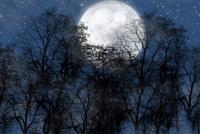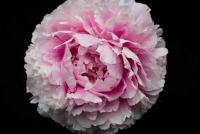Evergreen trees and shrubs. Coniferous and deciduous evergreen trees and shrubs
Evergreen and wintry trees and shrubs are widely used in landscape gardening. They can decorate your garden in winter, do not require special care and are rarely damaged by pests and diseases.
Evergreens
A characteristic feature of evergreens - pubescent or waxed leaves and cork layer on the stems.
Unlike deciduous plants, evergreens change their foliage not immediately, but gradually. Overwintered leaves or needles change to new ones after a few years, although this occurs in winter-green plants during the next growing season.
Almost all hvoyniki - evergreen, although some types of winter shed their needles. Among the evergreen and wintry are lianas, tall trees, shrubs, creeping forms and groundcover species, such as periwinkle, pakhisandra, hoofed dog.
Evergreens are used for site zoning and microclimate recovery. They also create a contrast with deciduous forms of plants, especially in winter.
Evergreens from the heather group, whose height varies from a few centimeters to a few meters, can be combined with conifers. They are used in Japanese gardens, in partial shade and sunny places.
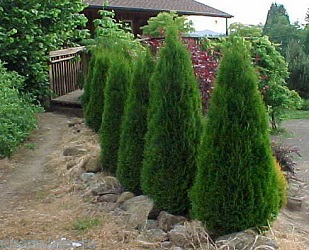
Choice of place

Many evergreens prefer protected from the scorching sun and cold winds of the place and non-drying soil.
In the right place, the plant will fully reveal its decorative qualities, will give beautiful flowering and fruit.
Conifers better overwinter if they are placed in groups, although some species, such as Scots pine, spruce and larch, normally tolerate wintering in open areas as a tapeworm.
These plants can be planted lastafter landing others ornamental trees and shrubs that will create a warmer and protected microclimate.
It is also worth noting that plants of one species relate differently to sunlight.
Planting evergreens
All year round, with the exception of the period when the soil is deeply frozen through, can be planted plants grown in containers. Evergreens with an open root system before planting should hold a few hours in water or a clay mash. Plants with a clod of earth, wrapped in sackcloth, are well planted in autumn, they manage to settle down until next spring.
Plants of the heather group - rhododendrons, azaleas, heathers, ericas, japanese pieris and calmia - like well drained acidic soil with a pH of 4.5-5, so it is advisable to add high-acid peat to the planting pit. Pine prefers sand, and spruce grow better on clay soils.
The basic landing rule is root neck of conifers and heathers should not be deeply buried, but should be at the level of the soil. Therefore, these plants are planted on a prepared mound or root collar when planted are left above the soil level by several centimeters, given that the soil will drain. It is also necessary to monitor the location of the root collar of rhododendrons, after breaking them out in the spring.
Moisture requirements and overwintering
Evergreens need for normal growing season. sufficient moisture available, especially under the bright sun, otherwise they will dry out.
This is especially true in the early spring and summer period, when the hvoyniki form young growths, which should have time to mature and overwinter normally.
Successful wintering of evergreens depends on soil structure and texture. On heavy clay soils with poor aeration, which thaw for a very long time in the spring, you need to constantly spray the crown of conifer or shade to avoid drying out of the plants.

Shelter for the winter

Winter hardiness evergreen depends on biological features species, growing conditions in nurseries and placement on the site.
For the shelter use non-woven material, special mesh, straw, lapnik.
You can pre-set the frame or tie the branches to protect them from breaking.
At the beginning of winter, the plants have high winter hardiness, and at the end of winter (in February — March) they lose their resistance, especially young plants.
Before the onset of winter, especially if it was preceded by a very dry summer and autumn, it is important to water the plants well and abundantly and mulch the tree trunks. Mulching will protect root system from freezing and reduce evaporation of moisture.
Evergreens
1. Common ivy (Hedera helix)
This shrub has green and variegated forms. It is quite hardy, but does not tolerate bright sunlight in the winter. In dark places, it can lose its variegation. Used in landscape design for vertical gardening, usually on the north side of the buildings.
2. Thuja western (Thuja occidentalis)
Needs quite fertile and moist soil. It tolerates a haircut and transplant at a young age. It has a large number of decorative forms and colors of needles. Recommended for single, group and aleynyh landings, as well as for the creation of "living" hedges and walls. Reaches a height of 10 m.
3. Nutskan cypress (Chamaecyparis nootkatensis)
The plant in an adult condition is up to 15 m high, has a hanging top and hanging side shoots. Light and moisture-loving, does not tolerate stagnant waters. Maintains frosts to -28 ° C. Prefer fertile loamy and sandy soils. Used as tapeworms.
4. Box evergreen (Buxus sempervirens)
Slow-growing shrub about 1 m high, with shiny leathery leaves. Prefers neutral and calcareous soils. Tolerates drought. Perfect for haircuts. Used to form topirovanyh forms and "live" hedges. If planted along a path with a concrete base, it is necessary to separate the concrete by waterproofing or water the plant well.
5. Mahonia is hollow (Mahonia aquifolium)
Slow growing shrub height of about 1 m. Frost-resistant plant tolerates partial shading. The most suitable is sandy or loamy soil, less dry and poor, it grows in urban environments. Planted in groups, make out "live" hedges and borders.

Most conifers are tall trees:
- pine
- fir
Among conifers and evergreens, many plants grow in the form of shrubs:
- boxwood
- many types of junipers (Cossack juniper)
- hollywood mahonia
- laurel (daphne)
- fatsia (Fatsia) Japanese
- aucuba (aucuba)
- camellia
- photinia (Photinia)
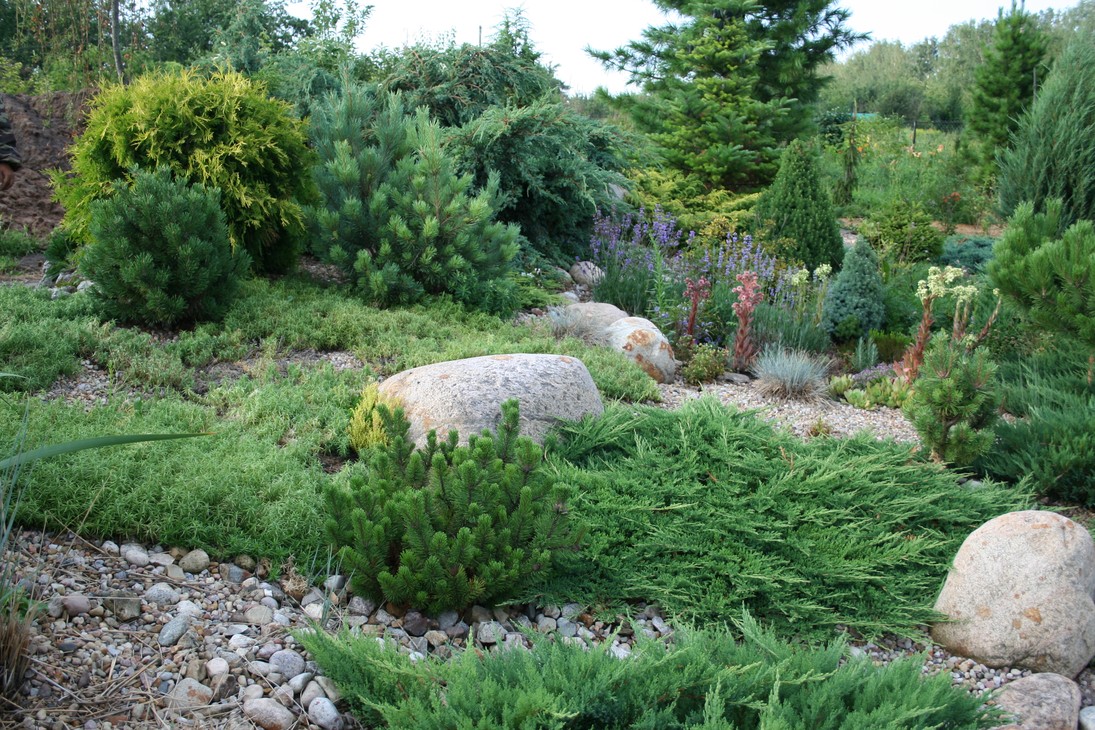
Ephedra for hedges
Spruce, thuja, fir, cypress trees are used by gardeners as an ideal background for garden and park plants. Chic hedge of evergreens (see more about plants for hedges) will not only outline the boundaries of your garden, cover you from curious glances, but also hide the disadvantages of the landscape.
If plants for hedges were eaten, then after 3-4 years of regular cutting, you can get a dense green screen that neither man nor animals can cope with. With the help of several tui or fir trees, the garden space can be zoned and its perception can be changed by planting plants taking into account the different shades of the color of the needles.

Without the use of additional materials, you can organize a quiet nest for reflection, a Japanese-style garden, or there may be a regular English park. And all this will not lose its decoration all year long! To make your garden look different every season, you only need to sit down to conifers and evergreen shrubs flowering perennials, annuals and bulbous flowers. The combination of coniferous plants and roses is considered the most spectacular and noble, by the way, roses also belong to evergreens and have coniferous and caring requirements.

Boxwood
Unusually look hedge from evergreen boxwood. The brilliant bright green foliage of this shrub gives a ceremonial look to the compositions, and an undoubted advantage is the ability to substitute the bushes of an evergreen boxwood. Topiary art - giving the plants different forms with the help of a haircut is another aspect of the use of coniferous evergreen trees and shrubs in the art of creating an ideal garden.
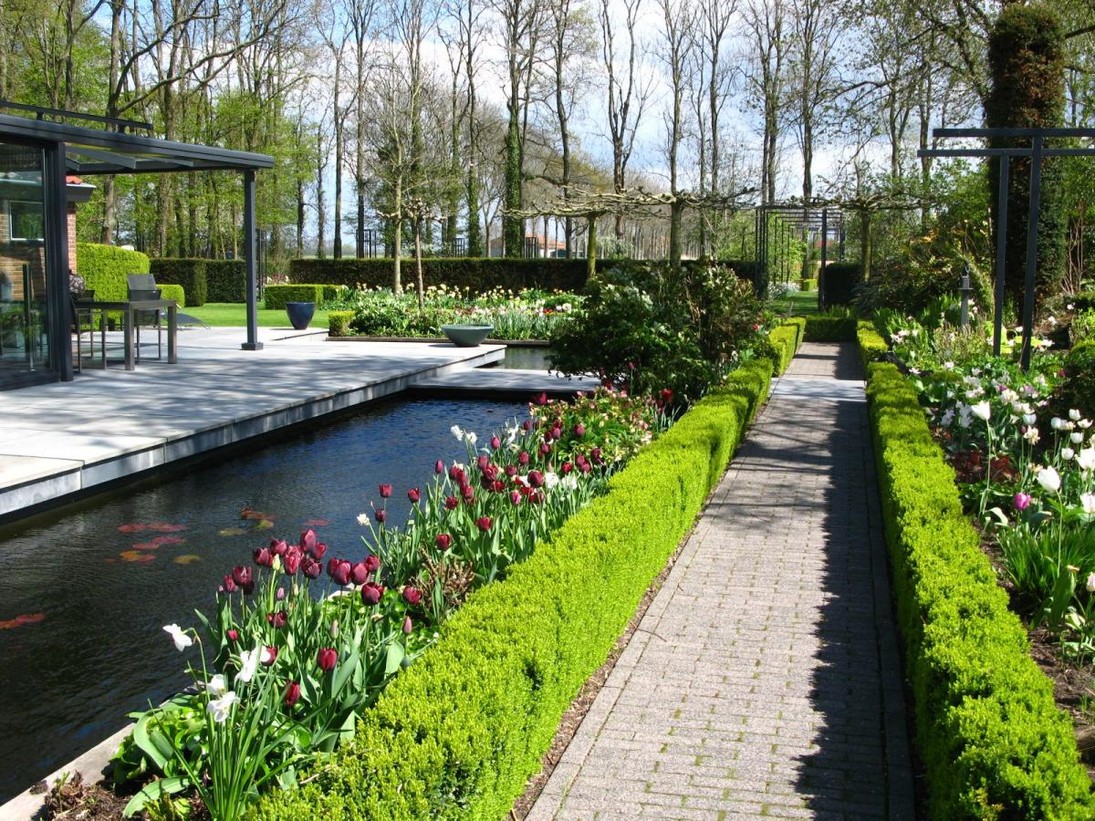
A variety of forms is not all the advantages of conifers. Conifers do not require special care and are rarely damaged by pests and diseases. The needles emit special substances-phytoncides into the atmosphere that are known for their qualities: to heal and purify the air, to positively influence the human respiratory organs. Healing air charges us with energy. Coniferous plants are decorative in summer, but, especially, they are beautiful, in the winter season, when they create a pleasant contrast with deciduous plant forms. Therefore, coniferous plants for the garden - an indispensable choice.
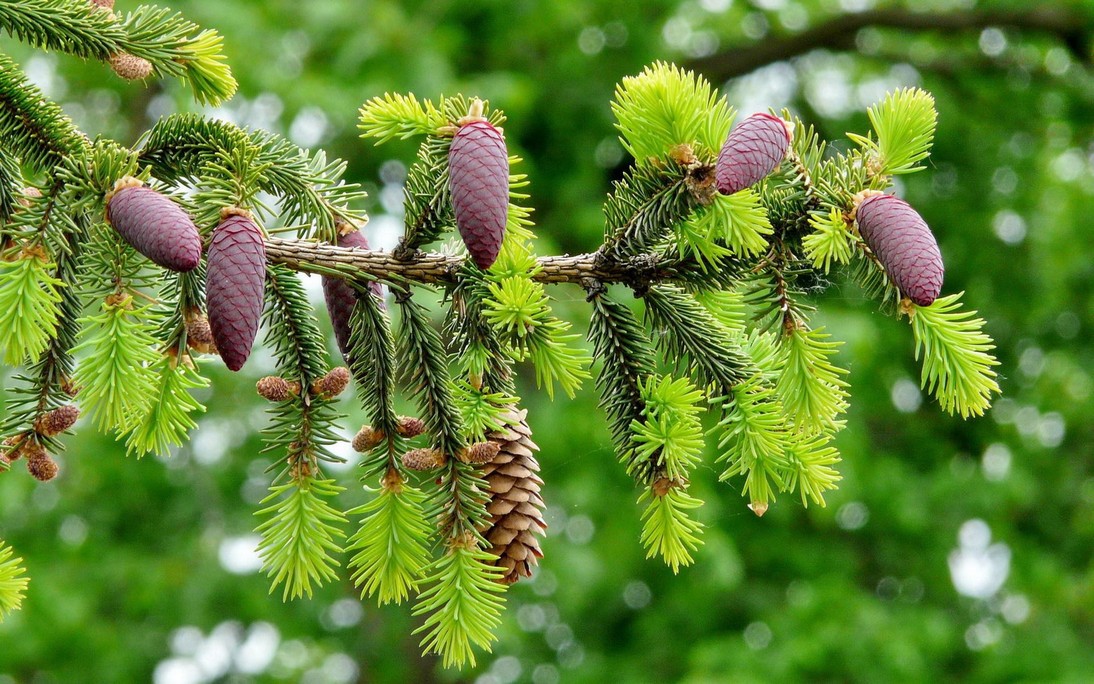
Due to its impressive size and amazing color of needles, compositions using coniferous plants will decorate any territory. Experiment, plant homochniki - dwarf, slowly growing forms of spruces, pines, thujas and junipers in rocky gardens and alpine hills. Covered with the paws of a juniper, plants of the rocky garden will be able to comfortably grow even in the sun.
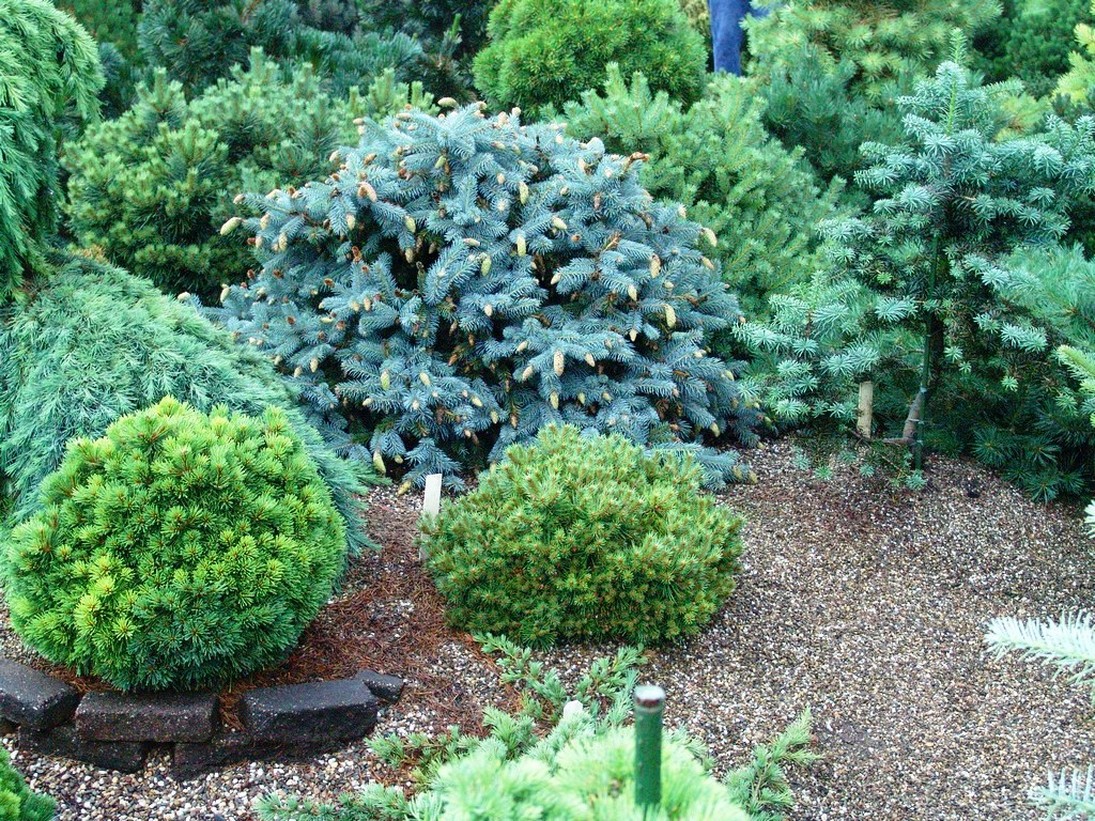
How to care for conifers and shrubs?
Watering. Mostly need watering young trees. They are abundantly watered at least once a week at the rate of 15-20 liters of water under the plant. Coniferous trees need to be watered abundantly in autumn - evergreen crops often dry out in the winter, not from the cold, but from a lack of moisture. Drought-resistant rocks (for example, pines) do not need additional watering, and such trees as thuja suffer from a lack of moisture.
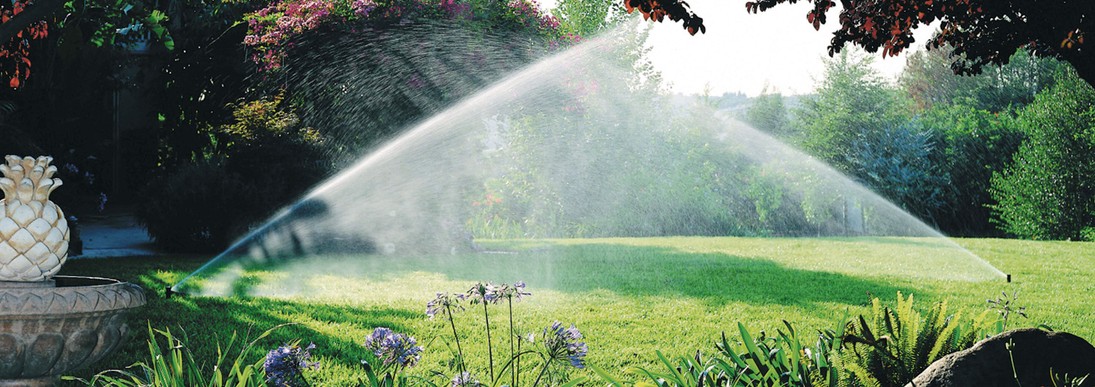
Sprinkling. All conifers need sprinkling, especially in spring and summer. In dry weather, sprinkling is good to spend in the morning or evening. During the first year after planting conifers, it is carried out every other day. Thanks to sprinkling, the needles are cleaned of dirt and dust.
Mulching - prevents drying of the earth, limits the growth of weeds and maintains the necessary temperature of the soil in the zone of the roots. The coniferous bark, peat and fallen leaves are used as a mulching material.
How to choose the right place in the garden for coniferous plants.
Many conifers prefer areas protected from the bright sun and cold winds, sufficiently moist soil and good drainage. Plant your coniferous plant in such a place, and it will fully reveal its decorative qualities. Most conifers winter better if placed in groups.

Coniferous plants that normally tolerate wintering in the open air are better suited for tapeworms. This may be pine, spruce, larch. Plant such coniferous plants together with other ornamental evergreen and deciduous plants, and you will create a warmer and protected microclimate.
Coniferous plants - one of the most popular plants in landscape gardening. Almost all conifers are evergreen and retain their decorativeness and appearance all year round, and only some breeds drop pine needles for the winter.
Due to the varied color of leaves and needles evergreen trees and shrubs You can create interesting compositions in the garden.
Evergreen conifers and deciduous trees and shrubs, which we have not paid attention to for some time, are now becoming fashionable again, they are planted to diversify the colors of the garden. Conifers, for example, have many different varieties of unusual coloring. They will be the perfect refuge for birds.
Yes, and among evergreen hardwood You can find varieties and species that attract our attention decorative leaves - shiny, with a white or yellowish border, as in the decorative forms of euonymus, sucker and many other woody.
Combinations with evergreen trees and shrubs
Liven up high green fence will help planted in front of her multicolored evergreens: Compressa Juniper and Potted Ivy; Forchun's euonymus; periwinkle and funky (host) (host) as ground cover; weeping cypress pea; hybrid sucker, holly ordinary; Chinese juniper. The red barberry can be added to the picture interspersed with boxwood in a low hedge.
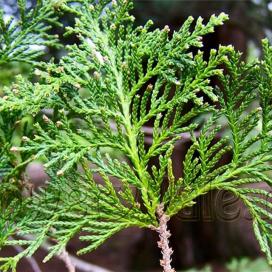

Spruce spruce is famous for its decorative needles of silver-blue color, which is why it is called blue spruce. The blue dwarf spruce with Forchun's creeping yellow-leaf euonymus stands in stark contrast. The creeping euonymus can crawl upwards like ivy. The silvery edge of its leaves stands out particularly brightly against the dark trunks of the trees.
Holly leaves have shiny dark green leaves with a yellowish-white border that color wood and garden all year round. In the fall, red berries will be added, which birds love to feast on. Privet is known for over 130 years. This shrub with yellow oval leaves deserves a solo performance.
A variety of evergreen plant well in front of deciduous trees and shrubs. In the summer, their restrained colors blend harmoniously into the overall color scheme, in the fall they create charming contrasts, for example, with red foliage or red fruits of other plants, while in winter, among bare trees, they generally become the main decoration of the garden.
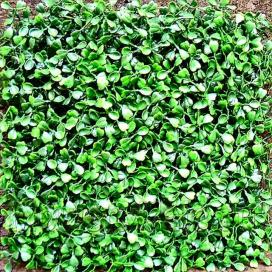

Yellow, white and silvery leaves (especially needles) significantly enliven the dark corners of the garden. As a ground cover here are suitable, first of all, different varieties evergreen creeping euonymus. For the selection of higher plants suitable holly varieties that can grow in a shady place. Ivy and some varieties of euonymus, for example, Emerald "s Gold and Variegatus, will be taken along the walls and pillars. They are especially spectacular against the dark bark of tree trunks. After climbing to the pergola or the trellis, they form a good protection from wind and outsiders.
Variegated evergreens are suitable not only for mixed group plantings.They are no less interesting as soloists, especially if they are distinguished by an unusual form of growth, for example, columnar or weeping. The color of a variety is often clear from its name. For example, if the name contains the word “Aurea” or “Gold”, it is a yellow-colored variety, the blue varieties are characterized by the word “Glauca”, for variegated silver-green - “Varigata” and “Maculata”.
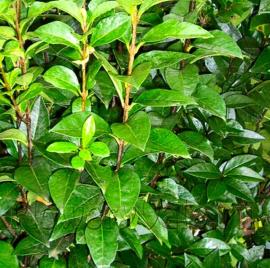
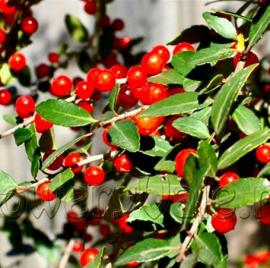
Planting and care
When assigning a place in the garden for evergreen trees and shrubs, you need to consider that they are more sensitive to winter cold than deciduous, so for them better fit a place protected from the north and east winds. It is advisable to plant saplings of trees with yellow needles in partial shade, if you plant in an open sunny place, you will have to take care of protection from the winds and the winter sun - the bright sun burns the needles, and in the shade they turn green.
The desired time for planting is spring or autumn, then the plants will root quickly, if the seedlings are purchased with an earthy ball, then you can plant at any time. In winter, coniferous and deciduous evergreens crown to reduce evaporation through the leaves. In the autumn, they are well watered throughout the autumn, so that in the winter their leaves or needles will not wither and dry.
Pruning in the early years is not needed at all, with the exception of a flat cut and the removal of dried twigs.
The first thing that comes to mind at the words: "evergreen ornamental shrubs" are coniferous representatives of the plant world. But in landscape design, deciduous evergreen shrubs are also successfully used.
Systematics
Evergreen ornamental shrubs are divided into coniferous and deciduous. From the point of view of biological taxonomy, all conifers are of the type of gymnosperms, and deciduous shrubs are of the type Angiosperms or Flowering. This systematic distinction is not accidental: these plants differ not only visually. In conifers and deciduous many differences in the internal structure and biochemical composition. This leads to differences in their planting, care and reproduction.
Deciduous evergreen ornamental shrubs
Deciduous evergreen shrubs - it is mainly the prerogative of tropical and subtropical climatic zones. Most of these plants growing in the temperate zone, for the winter you need to bring in the greenhouse or winter garden.
But there are some species that can withstand frost, and winter, without dropping the foliage:
- boxwood;
- honeysuckle brilliant;
- cotoneaster horizontal;
- holly-leaf mahonia;
- rhododendron (some species);
- forchun's euonymus;
- holly.
In addition to shrubs, there is a large group of ornamental shrubs that do not shed their leaves in winter either. These are all decorative representatives of the heather family - bilberry, lingonberry, heather, erica. Also, the representatives of the family of Labiaceae - lavender, rosemary, thyme. The latter need to be covered for the winter with leaves, shavings or spruce branches.
Deciduous evergreen ornamental shrubs are used in all varieties. landscape design, ranging from compositions, ending with hedges and topiary.
Coniferous ornamental shrubs

Among evergreens ornamental shrubs - coniferous plants occupy the first place. They will decorate the site, play the role of a fence or a curb, they grow slowly, so they do not need frequent cutting. Among coniferous shrubs there are those that can withstand the scorching sun, and those that can grow in deep shade.
- juniper;
- yew berry;
- eastern biota;
- spruce spiny;
- cypress;
- fir.
All conifers well tolerate winter, but do not tolerate excess water in the soil, it threatens to infect a fungal infection. On the other hand, coniferous shrubs can not tolerate long dry periods: the soil under them needs to be moistened.
Coniferous shrubs not only grow much slower than deciduous, but also need careful cutting, because of the specificity of branching.
In landscape design evergreen ornamental coniferous shrubs use:
- the creation of hedges and borders (yew berry, thuja, juniper);
- separately growing plant;
- rock caria and alpine hills (creeping forms of juniper, spruce, cypress);
- compositions with flowers and deciduous shrubs;
- topiary - the creation of figures from plants (yew).
Some believe that coniferous plants, possessing, as a rule, dark needles, lose deciduous shrubs in beauty. Indeed, in addition to beautiful leaves, these plants can boast of bright flowers and interesting fruits (for example, mahonia, holly, cotoneaster). But breeders brought varieties with colorful needles, variegated and bright, which make a worthy competition to any decorative leafy shrub.
Note: shrubs with motley needles need good lighting, they can not be planted in the shade.
Attention! Only today!
Even the most beautiful landscape design dacha or garden plot in the winter, it loses its charm, becoming gray and inexpressive. It seems that in a country with a harsh winter, it should be taken for granted, but fortunately there are evergreens for the garden.
, capable of year-round delight us with its brightness and riot of colors. And you need to take care of their landing now, before the onset of frost.GREEN PLANTS IN LANDSCAPE DESIGN
Choosing evergreens ornamental plants, many prefer the traditional needles. And this is not surprising, because coniferous plants look great throughout the year, can be easily cut, so they can be used to create various "live" sculptures and fences. However, in addition to the needles, there is a mass of garden crops that feel great even in the most severe frosts. Such plants include heather or wintering rhododendrons, privet, mahonia, periwinkle, pahisandra, laurel cherry, ivy, etc.
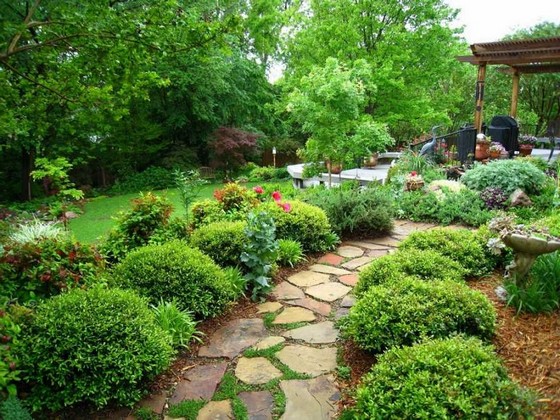
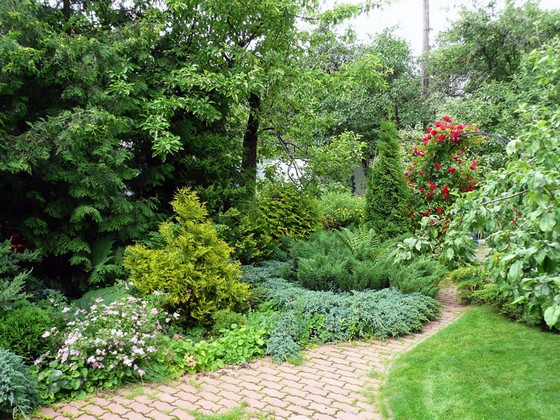
In the landscape design of the garden, evergreens can be used for zoning the territory of the site, creating decorative frames, growing “living” borders, hedges and sculptures, as well as masking household objects. Much less often such plants act as a solo object, however, when the right choice places and competently drawing up a common ensemble, these cultures will look great and as a single decoration.
Plants that endure the winter are relevant not only in open areas, but also in rabatki and flower beds. In rabatkah, they can be combined with almost any annual or perennial cultures, creating various patterns and ornaments, using them both as a supplement and as a background. It is better to plant evergreens on flowerbeds so that they are the main decoration of the composition, otherwise in winter these cultures will not be visible against the background of "asleep" vegetation.
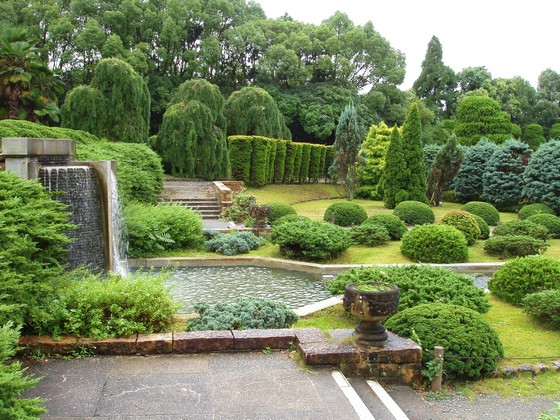
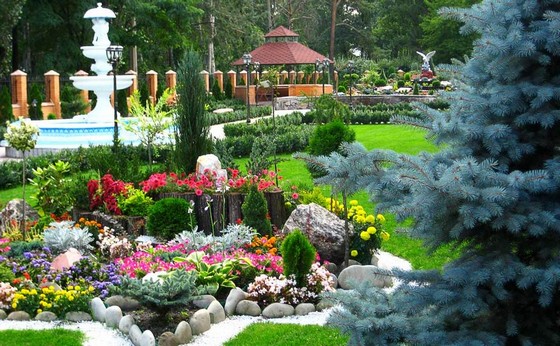
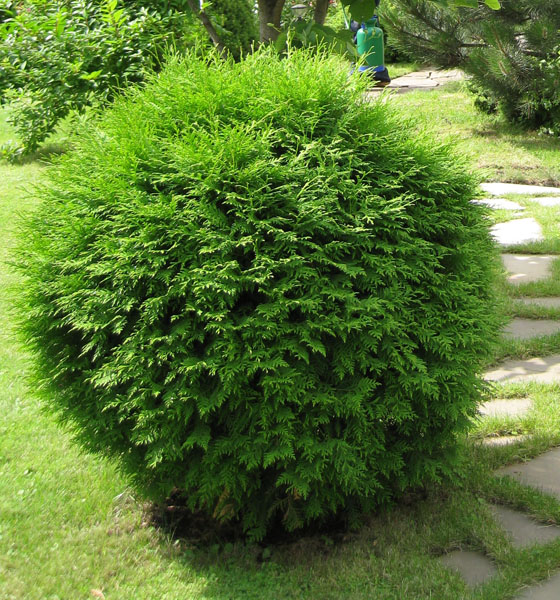
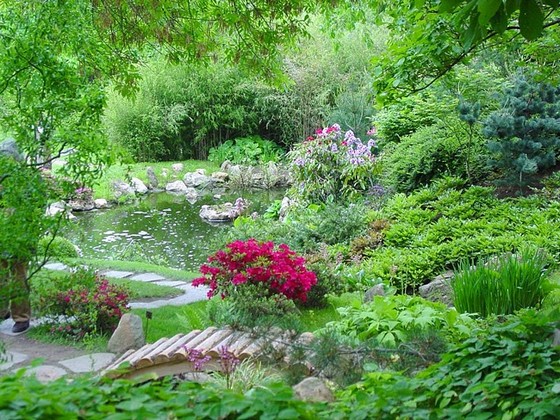

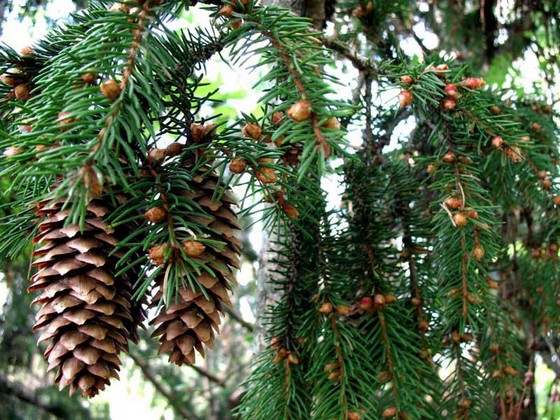
EARTH GREEN PLANTS FOR LOGGES AND BALCONS
Some plants belonging to the species of evergreen, will be of interest not only to gardeners, but also those who want to decorate their balcony or loggia in the winter. Evergreens for a balcony in the fall can be bought in a tub or a pot, and then transplanted into a suitable container. To the most unpretentious plantsIdeal for landscaping a balcony include: euonymus, Gaultery lying, pyranthantus, buxus, juniper, thuja, etc. Each of these plants is able to please their owners with different color, flowering and foliage shape. For example, an euonymus is distinguished by variegated purple-pink leaves, the lying goulter is decorated with bright red berries throughout the winter, and the color of thuja and juniper can consist of all shades of the green gamut.
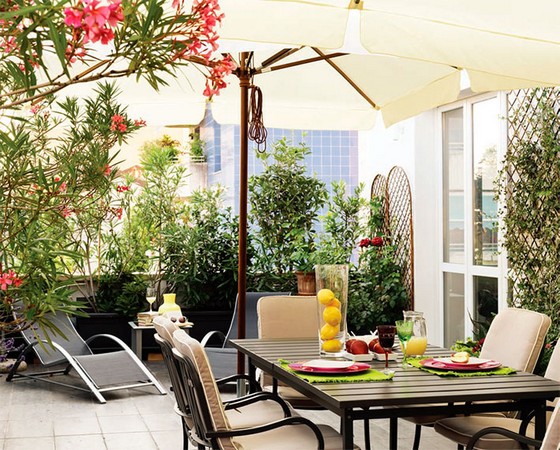
LIVING FENCE OR A HEDGE OF ETERNAL PLANTS
Even the most elegant garden fencing cannot be compared with the beauty of the “living” hedge, which becomes the main decoration of any landscape. Depending on the desired height of the hedge, it is possible to use low-growing evergreens, which include quince, yew repandes, yew eleganthissima, magonia, etc., or plants whose height can reach more than three meters (barberry, gibushnik, cherry felt, etc.). The most common evergreens for hedges include various types of barberry, spruce, hawthorn, boxwood and rosehip. All of these plants tolerate frost well, grow quickly, are not picky about soil composition and weather conditions, and are easy to cut.
If the “living” hedge is used for decorating the territory, then the plants or shrubs are planted in one row. If the fence performs the function of the scenes or the fence, then you need a thicker landing in two rows. Sometimes several types of plants are combined into a single composition.
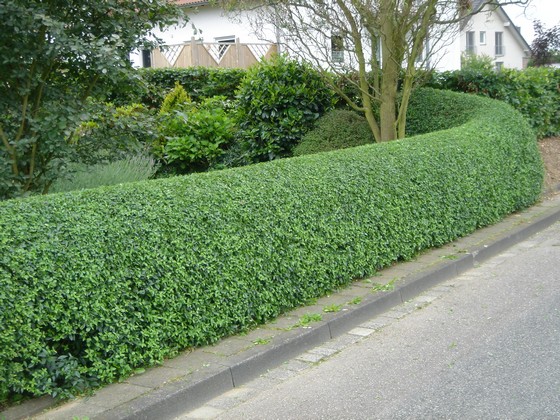

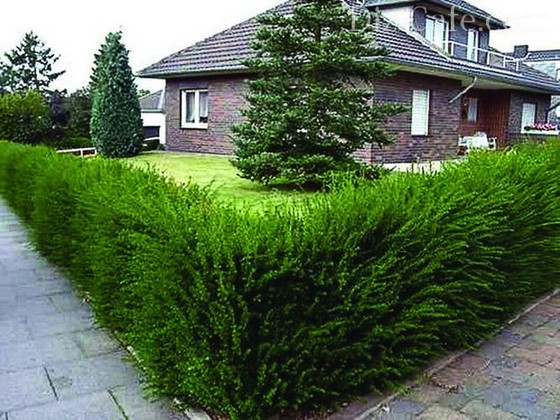
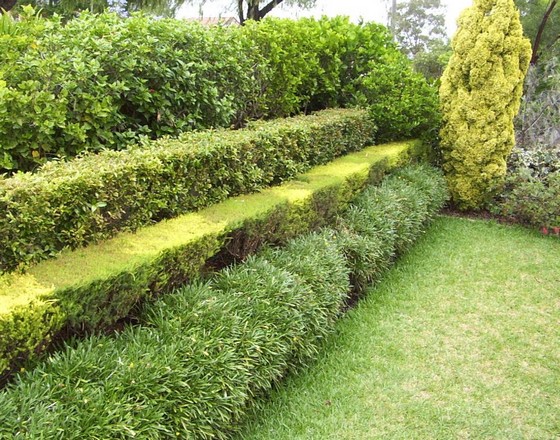
Instead of creating a “living” evergreen hedge, you can resort to decorating an already finished fence using climbing plants. Climbing evergreen plants for the fence perform their decorative function all year round, almost without changing their appearance. Ivy, wisteria, girlish grapes, etc. are plants that quickly and tightly wilt a fence or any other support. In addition to the fence, these plants can be used to decorate many landscape objects - arbors, trellises, outbuildings, etc.


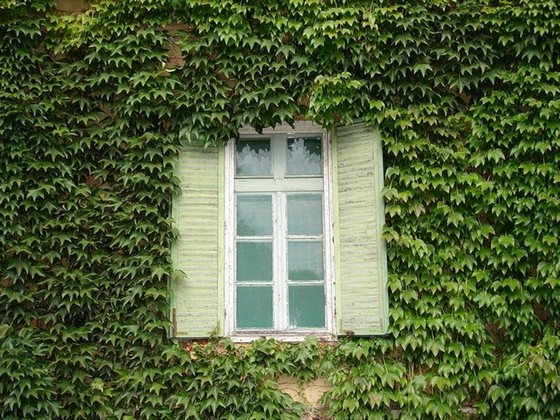
EARTH GREEN PLANTS FOR CREATING CURRENTS
Curb plants are ideal for creating borders between different zones of the garden, marking paths, paths and flowerbeds. But, in addition to its decorative value, these plants are necessary to prevent the growth of weeds and the growth of lawn grass. In spring and summertime, “live” borders delight gardeners with a thick crown and bright flowering, but with the onset of winter, many of them lose their attractiveness, destroying the unity of landscape design. In order to “live” borders delight you all year round, choose evergreen curb plants, which include boxwood, honeysuckle, Dubrovnik, Japanese spruce, etc. Some plants, such as boxwood and dubrovnik, can be pruned, giving them the necessary height.
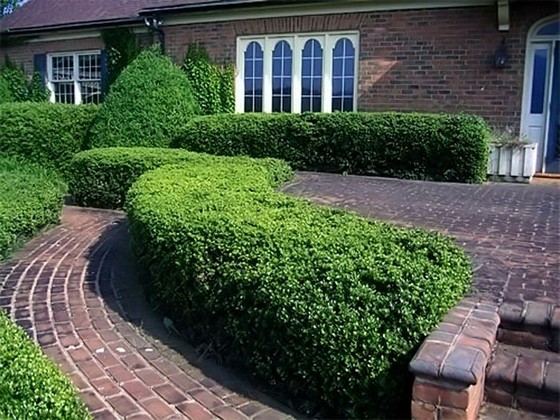
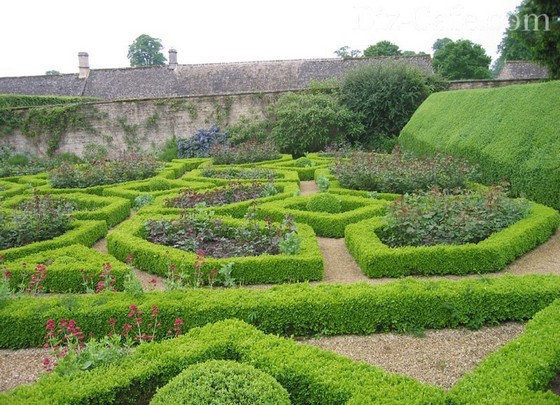
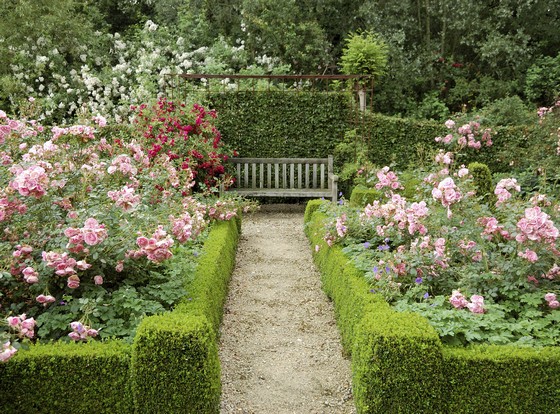
As a rule, evergreens do not need special care. However, so that they can fully reveal their decorative qualities, choose a suitable place for landing. These plants do not like the scorching sun and the soil is too wet. It is best to plant them in the penumbra, in a place fenced from strong winds.

Evergreen plants for the garden are able to decorate even the most perfect. landscape composition. However, in order to give gardening of the garden maximum expressiveness, it is necessary to disperse the plants throughout the site, planting them in small groups in each separate zone. In addition, planting plants in groups, combine varieties with different colors, otherwise winter landscaping will look gloomy and the same type.

